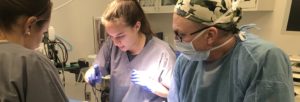As a proud affiliate of Georgia Tech, GCMI collaborates with Georgia Tech faculty frequently and we relish opportunities to support students as well.
Per the Capstone program’s home page, “Capstone Design is a culminating course offered to undergraduate students in several disciplines at the Georgia Institute of Technology. The Capstone Design course provides students the opportunity to work with real-world, open-ended, interdisciplinary challenges proposed by industrial and research project sponsors. They learn and apply the engineering design process: defining functional requirements, conceptualization, analysis, identifying risks and countermeasures, selection, and physical prototyping.
“Student teams design and build working, physical prototypes to validate their solutions. By working in teams they develop leadership skills and group dynamics; dealing with scheduling conflicts, meeting weekly deliverables and deadlines; and communication among team members, project sponsors, and course instructors.”
At the end of each semester, the participating students showcase their efforts at the Capstone Design Expo.
In order to give the Biomedical Engineering Capstone teams the chance to evaluate their medical device prototypes, GCMI provided Capstone teams access to a cadaver, our facilities, equipment and our staff expertise on November 18th enabling them to test their prototypes in a real OR.
Attempting to solve a taxing problem in spinal fusion surgery
One of the participating teams included Georgia Tech biomedical engineering students Gwyn Lando, Amanda Felouzis, Jenna Bush and Sydney Blanche who created a device for enhanced vertebral disc removal. The device, cleverly named “Discruptor,” seeks to improve the efficiency of the removal and breaking up of intervertebral discs prior to a spinal fusion procedure. Their prototype combines the two actions of breaking and scraping, while many tools currently on the market can only do one at a time.
“There are roughly 350,000 of these procedures done a year in the United States,” explained Lando. “According to the surgeons that we’ve spoken with, disc removal is the most taxing portion of the spinal fusion procedure.”
 Blanche elaborated, “Because the procedure is minimally invasive, [surgeons] are working through a small tube and there is potential for nicking spinal nerves. If disc removal can be performed with one tool, it can decrease the number of times that they have to go into that space and lowers the risk for the patient.”
Blanche elaborated, “Because the procedure is minimally invasive, [surgeons] are working through a small tube and there is potential for nicking spinal nerves. If disc removal can be performed with one tool, it can decrease the number of times that they have to go into that space and lowers the risk for the patient.”
The team members quickly realized that testing their prototype would prove challenging.
“We heard from some surgeons that the resected material is almost spongy but it pulls apart like crab meat,” Lando said. “We were going to try to pull crab meat from between two 3D-printed vertebrae.”
Providing access to high value resources and expertise to advance BME Capstone projects
Thanks to GCMI’s Capstone Day, the team was able to use their device in a highly clinical, practical situation.
“Being able to test the device in a cadaveric setting thanks to GCMI was the best opportunity we could have been afforded at this stage,” Lando said.
The group said that their device performed relatively well during the procedure. It is currently the first metal-made iteration of their prototype as well as their first time ever working with a cadaver. They agreed that the experience was extremely helpful in creating the final iterations of their prototype for the Expo.
When asked whether or not the team plans to take this device any further beyond the Expo, “We are submitting a provisional patent,” Felouzis said. It remains to be seen if the team members themselves advance the project further or if another party picks up on it.
“If someone would like to buy it from us, we are totally open to that,” she added enthusiastically.
The Fall 2019 Capstone Design Expo took place Monday, December 2.
